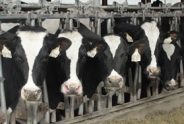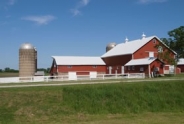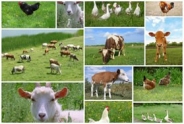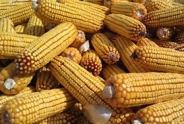Dairy Farm Risk Management Options April 2020
Katelyn Walley, Business Management Specialist and Team Leader
Southwest New York Dairy, Livestock and Field Crops Program
Christopher Wolf
Cornell University
April 3, 2020
Dairy Farm Risk Management Options April 2020
It would be an understatement to say that the current economic environment is one of uncertainty. The dairy markets are no exception. On January 22, futures contract Class III milk price was between $17.75 and $18.25/cwt from February through December 2020. Class IV futures were between $17 and $18.50/cwt. The resulting expected average margin from the DMC program was $10.86/cwt for 2020. The market fundamentals at that point in time very much supported a good farm milk price year with slow growth in the major exporting countries, a healthy economy, and more positive trade prospects. As of Friday, March 27 Class III futures were between $13.90/cwt (May) and $15.51/cwt (September). Dairy product and class prices continued to drop the following week.
With this rapid shift on prices, many questions are being asked about what options farms might have available to protect themselves from negative price changes. Milk price risk management options for US dairy farmers includes the Dairy Margin Coverage (DMC) program, crop insurance programs including Dairy Revenue Protection (Dairy RP), as well as cooperative options and futures and options contracts.
Dairy Margin Coverage Program
The DMC program is a program administered by the Farm Service Agency. DMC is the second incarnation of the Margin Protection Program (MPP) that was modified in the 2018 Farm Bill. The program uses a national income over feed cost estimate calculated using the US All Milk Price as well as the NASS US corn price, supreme alfalfa hay, and Central Illinois soybean meal price.
Sign up for 2020 DMC coverage took place from October into December 2019. Some producers signed up for 5 years of coverage (2019-2023) and took a discounted premium. From the enrollment data, of the 28,000 or so herds with a production history 13,000 signed up for 2020. Some of these did so at the $4/cwt margin level. Nationally, 11,000 herds enrolled for 2020 at $9.50/cwt level covering 28.3 billion pounds of milk (about 12.8% of expected milk production).
For New York, 683 herds enrolled at $9.50/cwt (17.6% of herds). 15.12 billion pounds of New York milk were enrolled at $9.50/cwt for 2020 representing 10.25% of 2019 milk production.
The DMC average margin on March 27 was $8.33/cwt for 2020. Actually, that margin did not look so bad in a longer historical context but that is still a loss of $2.50/cwt in projected income over feed margin in 9 weeks and it does not reflect the deep financial hole many producers find themselves in following the last few years of poor returns. DMC payments are projected to be $2.95/cwt in June but that will be for a maximum of 4,167 cwt so the monthly payment would exceed $12,000 prior to netting out the premium.
Expected 2020 DMC payments as of Friday, March 27 on 5 million covered pounds of milk production at $9.50/cwt totaled just shy of $60,000 even when netting out the $0.15/cwt premium (UPDATE: As of April 1 the total was now in excess of $90,000 but this depends on actual milk and feed prices in future months). The futures markets is currently predicting a bit of a recovery in margins in the fall months with payments ending. Should COVID-19 continue, it seems likely that may deteriorate resulting in a higher payments. Depending on the farm size and financial situation, the expected DMC payments may be very useful. If producers are not signed up for DMC in 2020, at this point it is no longer an option. Perhaps lawmakers will re-open DMC enrollment for 2020 but that remains to be seen.
General information about DMC is at:
https://www.fsa.usda.gov/progr...
A very useful tool to examine expected DMC margins and probabilities of triggering by margin protected is available at:
https://dairymarkets.org/MPP/T...
The values for expected DMC margins are updated with each trade day. Using this information, farms can assess the expected payments and assistance for 2020.
Dairy Revenue Protection Insurance
Dairy-RP is an insurance program administered by the USDA-Risk Management Agency. It allows producers to cover milk price using Class III or Class IV milk prices by quarter based on current futures contract prices. Producers can cover up to 95 percent of the average quarterly milk price with subsidized premiums. Butterfat and protein components may also be covered using this program which may be desirable to producers with high herd tests.
As of the end of January about 3 billion pounds of milk were covered for 2020 under Dairy-RP which is about 1.5% of expected annual total. At the present time, the decision to lock in those prices looks brilliant. Unfortunately, it makes less sense to lock in prices where they are currently are at as would be considerably below costs of production for most farms and may be near the bottom. Are we at (or near) the bottom? In the nearby months, there are few opportunities at the current time that will excite dairy farmers. $12.60/cwt Class III is very low—the last time milk prices were at this level was October 2009. For Dairy-RP, it would appear there might be opportunities in the first or second quarter of 2021. Of course, that is of little use for short-run but may limit risk if uncertainly continues over the year. Interested farm managers should monitor the futures prices for opportunities. If the virus is short-lived, markets may recover with more typical economic activity.
Dairy futures and options prices are available at:
https://www.cmegroup.com/tradi...
General Dairy-RP information is at:
https://www.rma.usda.gov/en/Fa...
Dairy RP premium calculators are available from crop insurance providers and others that sell the policies including Farm Credit.
Private and Cooperative Price Risk Management
Producers may utilize futures and options for milk (on the Chicago Mercantile Exchange website above), corn, soybeans (Chicago Board of Trade) and other commodities through brokers. Many cooperatives also offer programs that use the underlying futures and options contracts but offer more contract size flexibility.
Price Risk Management Considerations
If the farm financial situation is such that catastrophic milk prices must be avoided then the farm manager must act accordingly (unfortunately, we may already be there for much of 2020). Financial analysis can inform managers whether risk management is desirable but not what to do or when. One tenet of economics is that producers should at least cover the variable (operating) costs in the short-run. In the long-run, all costs must be covered. In recent years, farm milk prices have been boom or bust with some years below cost of production for many producers. In periods, when milk prices are below cost of production, the objective turns to minimizing losses. When assessing future prices, it is useful to benchmark them to costs—in particular operating costs. Keep in mind that milk futures prices in far out months are a best estimate with current information. These values have the potential to change with new market information. So one must ask, is it desirable to lock in a loss or in a low margin, or pay a high insurance premium, or to wait for the opportunity for higher prices?
Dairy Farm Risk Management Options April 2020 (pdf; 464KB)
Upcoming Events
Crops, Cows & Critters - Southwest New York Dairy, Livestock & Field Crops Newsletter Sponsorship
December 19, 2025
Our two forms of publications feature research-based and timely information from our four specialists, listed to the right, along with local event notifications and Cornell University outreach. This information is provided to participants who range from dairy, livestock, and field crops producers to agricultural suppliers and consultants.
Weekly Email Update: Shared with 625+ households who have signed up with our program.
Monthly Paper Mailer: To reach our stakeholders and farmers who lack internet access, we send out a monthly mailer where your company's logo and contact information would be featured with a mailing list of 330+ households.
If you sponsor our weekly and monthly publications you reach approximately 955 households.
Visit our website to view our newsletters!
2025 Cornell Food Beverage & Animal Feed Manufacturer Survey
December 19, 2025
Industry and Educational Advocates for New York State's Food, Beverage, and Animal Feed Manufacturing industries:
As you know, NYS has a diverse food and beverage manufacturing industry, in both the types of industries that exist and the wide distribution of firms by scale. Many manufacturing firms have strong backward linkages to agricultural production sectors in the state that support both farm-level and downstream food industry firms and consumers. In collaboration with the New York State Department of Agriculture and Markets, a team from Cornell University's Charles H. Dyson School of Applied Economics and Management has recently rolled out the 2025 New York State Food, Beverage, and Animal Feed Manufacturer Survey. The industry will benefit from an updated assessment of the industry that informs private and public investments and opportunities to support firm growth and improved profitability.
Cornell Organic Field Crops & Dairy Conference
March 6, 2026
Waterloo, NY
Farmers, researchers, educators, and agricultural service providers from across the Northeast are invited to the 2026 Cornell Organic Field Crops & Dairy Conference, held Friday, March 6, 2026, from 8:00 a.m. to 4:30 p.m. at the Lux Hotel & Conference Center in Waterloo, N.Y.
Co-hosted by New York Soil Health and Cornell CALS, the annual conference brings together leaders in organic grain, dairy, and livestock systems to share practical tools, new research, and farmer-tested strategies to support resilient and profitable organic production.
Announcements
No announcements at this time.





